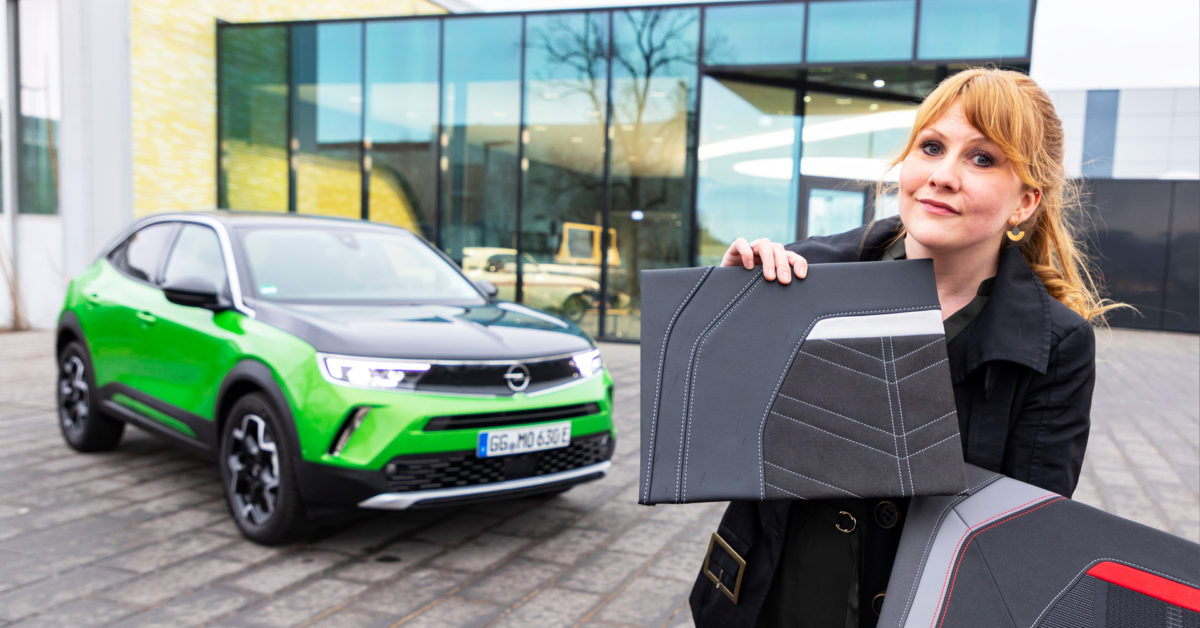Please tell us briefly about yourself.
I was born in 1986 in the beautiful Lüneburger Heide and studied “Textile, Art & Design” in Germany, England and Austria after completing my A levels. For more than six years now, I have been working as a “Colour & Trim” designer at Opel. In my free time I like to be outdoors in nature, I am a passionate tennis player and am interested in environmental and animal protection projects.
What does a typical working day look like for you?
The “Colour & Trim” team is responsible for all visible and tangible materials and surfaces. The core of our work is the creative and strategic development of material, graphic and colour concepts up to the realisation of the finished product. Our department has a particularly large number of interfaces with other corporate divisions. Therefore, we are in constant dialogue with our colleagues from exterior and interior design, marketing, purchasing, the engineers and of course the suppliers. There is no “typical” working day. Planning is only possible to a certain extent and every day looks a little different.
Can you tell us if the male and female designers in your team work differently?
Personal taste plays less of a role in our work, what is much more important is the relevant expertise and competence. But there are different ways of achieving a common goal, so to speak. A concrete example is the use of different sources of inspiration. Especially in the search for colour, material and surface trends, I like to use magazines for architecture, furnishing and decoration. Of course, I also follow trends in the fashion world and like to look at new developments in consumer electronics.
Your work combines a lot of design and technology. In your opinion, do women and men have different preferences and needs here?
I am very enthusiastic about technology myself and I think that the combination of design and technology is exactly what working as a designer in the automotive sector is all about. The requirements, which also include responding to customer needs, make my job so exciting.
Every development is closely linked to technical functions and every single element, from the seat material to the complex module, is subject to high technical as well as innovative requirements. Our team always works towards achieving the best possible user experience. Functionality, intuitive operation and design always belong together and must fit into the overall concept. In my experience, there are no clear dividing lines between female and male positions. On the contrary, we benefit from each other’s diverse perspectives.
Especially in the search for colour, material and surface trends, I like to use magazines for architecture, furnishing and decoration.
You were involved in the design of the new Opel Mokka. What was particularly important to you there?
In addition to the visual impressions, the haptic and sensory aspects of the many different components are always important to me personally. Basically, it was important for us in the team to develop a holistic concept for the exterior and interior that underlines our design philosophy. The proportions and lines, the bold and pure design language, the use of innovative materials as well as details in the form of surprising colour accents embody precisely this design philosophy and spark emotions. The new Mokka is an excellent example of this.
But I also particularly like the technical innovations, such as the so-called “Pure Panel”, a fully digital high-tech cockpit, which stands out as a design element and shapes the interior. Our new Mokka embodies modern and timeless design, self-confidence and elegance. And I’m sure our newest family member will appeal to women and men alike.
Women are said to have a greater affinity for electric cars than men. What is your assessment of this?
In fact, I just read recently that women are said to be more environmentally aware, although a concrete explanation was not given in the article. In any case, I myself am very interested in ecology, environmental protection and sustainability. I am therefore pleased that these topics are playing an increasingly important role these days and are coming more and more into focus in the areas of economy, environment and society.
This is also reflected in my work as a designer and concerns not only the future of drive technologies, but also all materials and processes, including in interior and exterior design.
E-mobility is a topic that concerns us all. Opel is shaping the future with e-mobility in a way that is open to technology, with outstanding design and the driving pleasure. This requires different concepts to suit the respective usage profile, customer taste and product character. But there is no gender division here either.
I am very enthusiastic about technology myself and I think that the combination of design and technology is exactly what working as a designer in the automotive sector is all about.
Unfortunately, it is still a reality that women reach management positions more seldom than men. Do you have a tip for enthusiastic young female designers who dream of a career like yours at Opel?
Don’t shy away from challenges! Be brave and seize opportunities, even if that sometimes means jumping in at the deep end.
Apart from that, it’s very valuable to make contacts and build your network early on. I already did internships and gained experience abroad during my studies. I now benefit from this every day in my professional life.
Another advantage is being broadly based – a good mix of creative expression, but also analytical, rational thinking. Equally important, of course, are social-communications skills. Finally, I can strongly advise everyone not to lose their sense of humour even in stressful times.
Thank you very much for the interview!
